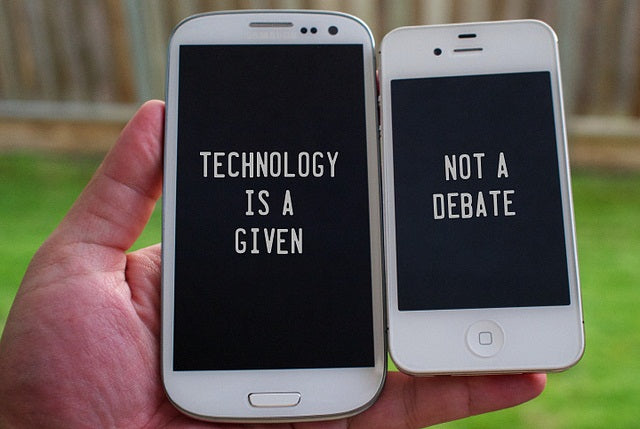For over a decade, the New Media Consortium (NMC) has been charting the landscape of emerging technologies in teaching, learning, and creative inquiry on a global scale. The NMC’s advisory board includes 750 technology experts and faculty members from colleges and universities in 40 countries, and is supported by the Consortium for School Networking (CoSN) and the International Society for Technology in Education (ISTE).
The NMC’s latest research efforts, the NMC Horizon Report: 2013 K-12 Edition and the NMC Horizon Report: 2013 Higher Education Edition, were released this spring, and together highlight ten emerging technologies that will impact education over the course of the next five years: cloud computing, mobile learning, learning analytics, open content, 3D printing, MOOCs, virtual and remote laboratories, games and gamification, tablet computing, and wearable technology.
Love teaching? Study the Certificate III in Education Support online
As an educator, you have probably heard about many of these technologies, if not all of them. But the Horizon Report project pushes the discussion into fresh territory, predicting a timeframe for their implementation into mainstream education and presenting an impressive list of institutions and individuals who are already using them in every discipline imaginable.
Too often it is education’s own practices that limit the broader uptake of new technologies. Whether it’s insufficient ongoing professional development or the reluctance to accept the need for digital media literacy, significant challenges stand in the way of smooth assimilation.
What the Horizon reports show, however—even more than which technologies are rising to the top— is that smooth assimilation is possible, and that countless educators are making the move creatively and with admirable conviction.
Here is a little inspiration from the people who are doing it right:
1. Cloud Computing (12 Months or Less)
In 2011, cloud computing was listed in the 12-month-or-less category of the report, primarily because of the way it had become an essential part of collaboration in both schools and the workplace. This year, the placement of cloud computing on the near-term horizon for a second time underscores the fact that the impact of this technology continues to unfold in new and expanding ways.
Language: The cloud-based Brazilian Electronic Learning Organizer helps language teachers produce and share digital learning objects and activities for their students. The learning objects are created by the teacher or assembled from a resource repository created by other teachers in the network.
Science: California State University Northridge launched the Computer Supported Collaborative Science initiative to help science teachers in high-need Los Angeles-area schools to engage students in authentic research experiences through the use of cloud-based tools.
Social Studies: Powered by cloud computing, the Global Curriculum Project allows students to participate in a virtual exchange program with school across five different countries. Students select and explore their own topics, including cuisine and ambitions.
2. Mobile Learning (12 Months or Less)
By the end of this year, the mobile market is expected to consist of over 7 billion accounts (equating to about 3.4 billion users, or one in every two people on the planet); mobile traffic on the Internet is expected to surpass desktop traffic; and mobile users will have downloaded 70 billion apps across smartphones and tablets. Educational apps are the second-most downloaded in iTunes of all categories, surpassing both entertainment and business apps in popularity.
Mathematics: Year four students at St. Leonard’s College, a primary school in Australia, are using tablets loaded with math apps and e-textbooks to access information, receive instruction, record measurements, and conduct research.
Music: Students at Institut International de Lancy in Switzerland use their tablets to create music in the school’s first iPad Orchestra. The iPads have provided opportunities for students with little to no training to create their own music with classmates.
Storytelling: Ringwood North Primary School in Australia participated in “The Epic Citadel Challenge,” wherein students and teachers collaborated to write a digital story based on the Epic Citadel environment and turn it into an app accessible via iOS mobile devices.
3. Tablet Computing (12 Months or Less)
It is so easy for students to carry tablets from class to class, using them to seamlessly access textbook and other course material as needed, that schools and universities are rethinking the need for computer labs or even personal laptops. A student’s choice of apps makes it easy to build a personalized learning environment, with all the resources and tools they need on a single device. With their growing number of features, tablets give traction to other educational technologies— from facilitating the real-time data mining needed to support learning analytics to offering a plethora of game-based learning apps.
Art: At Plymouth University in the UK, students working toward their Illustration degree are using iPads with an illustration app called Brushes to produce drawings that can be played back as video. This activity is encouraging reflection and discussion on the drawing process and enabling students to contrast techniques and highlight and correct any bad habits.
Science: Students at Redlands College in Australia are using tablets to collect and share data on indigenous rocks; geology majors at the College of Wooster in Ohio are using them to take and annotate photos of Icelandic terrain; and instructors at Yale University are sharing images from their digital microscopes with students’ iPads through mobile apps so that they can annotate and capture images for future use.
Journalism: Professor Messner at Virginia Commonwealth University secured iPads for his students so they could create multimedia news stories from happenings on campus and in the surrounding community. The students learned the importance of social media in journalism and found the iPad useful for gathering news and sources.
Special Needs: Vanderbilt University graduate students are designing an Android app that enables visually impaired students to learn math. Using haptic technology integrated into new touchscreen devices, the vibrations and audio feedback help students feel and hear shapes and diagrams.
4. MOOCs (12 Months or Less)
A number of respected thought leaders believe that the current MOOC model has deviated significantly from the initial premise outlined by George Siemens and Stephen Downes in 2008, emphasizing lecture over connectivity, but either way, educators across the globe are doing some amazing things with MOOCs. The hope is that they will eventually strike a balance between automating the assessment process while delivering personalized, authentic learning opportunities.
Music: This spring, Indiana University-Purdue University Indianapolis and the Purdue University Department of Music and Arts Technology began offering their first MOOC, “Music for the Listener” that can be converted into credit. The learning environment is being delivered through Course Networking, with full translation features, rich media, and social networking tools.
Physics: An MOOC called “Landmarks in Physics,” pioneered by an MIT graduate and delivered through Udacity, takes students on a virtual tour through Italy, the Netherlands, and England while explaining the basic concepts of physics at the sites of important discoveries in world history.
Writing: Ohio State University has partnered with Coursera to create a course that engages participants as writers, reviewers, and editors in a series of interactive reading, composition, and research activities with assignments designed to help them become more efficient consumers and producers of alphabetic, visual, and multimodal texts.
5. Open Content (2-3 Years)
While open content has been available for a long time, the topic has received increased attention in recent years. The use of open content promotes a skill set that is critical in maintaining currency in any area of study—the ability to find, evaluate, and put new information to use. The same cannot be said for many textbooks, which can be cumbersome, slow to update, and particularly costly for K-12 schools. More educators are tapping into the wealth of content within open repositories and familiarizing themselves with the Creative Commons protocol.
History: Learn NC is a program developed by the University of North Carolina at Chapel Hill School of Education to make resources and best practices in K-12 freely and widely available. Their digital textbook for eighth grade history contains a collection of primary sources, readings, and multimedia that can be searched and rearranged.
Mathematics: Arizona instructor James Sousa, who has been teaching math for 15 years at both the community college and K-12 levels, developed more than 2,600 video tutorials on topics from arithmetic to calculus, all of which are licensed under a Creative Commons Attribution.
Science: A partnership between Bringham Young University’s David Wiley and the Hewlett Foundation sparked a project in which teachers from 18 districts and four charter schools across Utah pulled together science resources to create free digital textbooks.
6. Learning Analytics (2-3 Years)
While analyzing student data is not a new practice, the field of learning analytics has only recently gained wide support among data scientists and education professionals. In the coming years, as learning analytics platforms become increasingly complex and effective, outcomes of learning analytics will have a significant impact on the evolution and refinement of both K-12 and higher education, especially in the design of personalized and online learning platforms.
Mathematics: Developed by a group of educators, programmers, and data scientists, Mathspace is an online program that meets the demands of the NSW syllabus and Australian National Curriculum for students aged seven to ten. The platform monitors how students reason through math problems and provides personalized feedback as well as analytics reports for teachers.
Reading: Kno, an e-textbook company, launched the “Kno Me” tool, which provides students with insights into their study habits and behaviors while using e-textbooks. Students can also better pace themselves by looking at data that shows them how much time they spent working through specific texts, and where they are in relation to their goals.
Writing: The University of North Carolina Greensboro uses the Mobius Social Learning Information Platform to create intensive writing courses which facilitate anonymous, peer-to-peer feedback and grading. When students submit an essay, it is automatically distributed to the rest of their randomly chosen peer group, and an algorithm turns their feedback into statistics and performance reports.
Special Education: Constant Therapy is a mobile platform that leverages data analytics and mobile technology to provide personalized therapy for people with cognitive, language, communication, and learning disorders. With 15 years’ worth of content developed by Boston University, Constant Therapy’s lessons adapt to meet the needs of learners while allowing language educators to monitor their progress via an analytics dashboard.
7. Games and Gamification (2-3 Years)
Game play has traversed the realm of recreation and infiltrated commerce, productivity, and education, proving to be a useful training and motivation tool. Referred to as “Game-Based Learning” in previous NMC Horizon reports, this field of practice has expanded far beyond integrating digital and online games into the curriculum. The updated category title reflects the perspective that while games are effective tools for scaffolding concepts and simulating real world experiences, it should also include the larger canvas of gamer culture and game design.
Architecture: SimArchitect is a simulation game and social connection site for architects developed by IBM Center for Advanced Learning. Players are issued a request for proposal by a fictitious client and must respond, conducting meetings with the client and team and then proposing a solution. IBM created a performance scorecard that evaluates the player’s communication, architectural methods, and more.
History: The Historical Williamsburg Living Narrative project at the University of Florida is an effort to create an interactive fictional game in which the geography, culture, and characters of Colonial Williamsburg, Virginia will be brought to life. Functional maps show the early architecture of the buildings, and interactive scenarios with characters like George Washington and Patrick Henry allow students to participate in discussions of the times.
Nursing: The University of Minnesota’s School of Nursing has partnered with the Minnesota Hospital Association and the technology firm, VitalSims, to develop web-based interactive games that engage nursing students with real-life scenarios. With initial versions of the game already completed, health care educators are expecting to launch these digital learning tools later in 2013.
8. 3D Printing (4-5 Years)
While 3D printing is four to five years away from widespread adoption in schools, it is easy to pinpoint the practical applications that will take hold. Geology and anthropology students, for instance, can make and interact with models of fossils and other artifacts, and organic chemistry students can print out models of complex proteins and other molecules through rapid prototyping and production tools. Even more compelling are institutions that are using 3D technology to develop brand new tools.
Archaeology: Harvard University’s Semitic Museum uses 3D printing technology to restore damaged artifacts from its collection. For example, by 3D scanning existing fragments of an Egyptian lion’s legs, researchers can create computer models that will be used to print a scale foam replica of the complete structure, even though it was originally missing its body and head.
Astronomy: In an effort to engage inner-city students in STEM-related fields, Minnesota non-profit STARBASE has created an aerospace-themed curriculum where students plan a mission to Mars. A highlight of the project is the use of 3D printing technology to create a working rocket that students launch on the final day of the program.
Business: In early 2013, Darwin High School in Australia initiated a project intended to expose students to micro-business concepts through product development and workflow analysis. Using 3D printers, students rapidly prototype ideas, explore product design, and learn how to market their goods.
Computer Science: Students at Glacier Peak High School in Washington can receive college credit for taking computer-aided design classes featuring the incorporation of 3D printers for rapid prototype development. The courses include modeling and design, tolerance specification, documentation drawing, and assembly modeling.
9. Virtual and Remote Laboratories (4-5 Years)
Virtual and remote laboratories reflect the current trend in K-12 education toward more authentic online education. Though technology is four to five years away from mainstream use in schools, the benefits of implementation are already clear. Virtual and remote labs offer flexibility, as students can run experiments as many times as they like, both in and out of school. Because these labs are designed to allow for easy repetition of experiments, students feel less pressure to execute perfectly the first time. In the controlled environments of these labs, students are safe, even if they make an error.
Chemistry: Dr. David Yaron, Associate Professor Chemistry at Carnegie Mellon University, developed ChemCollective, a project of the National Science Digital Library, to create flexible interactive learning environments in which high school students can approach chemistry more like practicing scientists.
Marine Biology: In Lysekil, Sweden, high school students use virtual tools to explore the marine environment of Gullmar Fjord on the Swedish west coast, learning in the process how scientific knowledge is created. The students use a virtual ocean acidification laboratory to conduct studies on the acidification of the marine environment.
Mathematics: High School students in North Carolina are using Geometer’s Sketchpad to understand how theorems are developed. The software is accessed through North Carolina State University’s virtual computing lab, a cloud-based learning environment with an interactive online community where teachers share tips on the software used as well as the projects undertaken.
10. Wearable Technology (4-5 Years)
Perhaps the least educationally applicable but most complex technology of the NMC report is wearable technology. Google’s “Project Glass” is one of the most talked-about current examples. One of the most promising potential outcomes of wearable technology in higher education is productivity: tools that could automatically send information via text, e-mail, and social networks on behalf of the user—based on voice commands, gestures, and other indicators— that would help students and educators communicate with one another, keep track of updates, and better organize notifications.
Chemistry: A team from the Centre for Sensor Web Technologies at Dublin City University is building a wearable sensor that detects hazardous gases and immediately alerts the user of these conditions.
Geology: Wearable cameras like Memoto, a tiny GPS-enabled camera that clips to a user’s shirt collar or button and takes two five-megapixel shots per minute, could benefit geologists or archaeologists in the field, capturing hundreds of photographs or data about a user’s surroundings on an offsite dig which can later be accessed via e-mail or social media.
Neuroscience: A new brain-sensing headband called Muse displays a user’s brain activity directly onto their smartphone or tablet, in effect making it possible to control actions with one’s thoughts and to collect data about the brain’s reaction to various stimuli.









